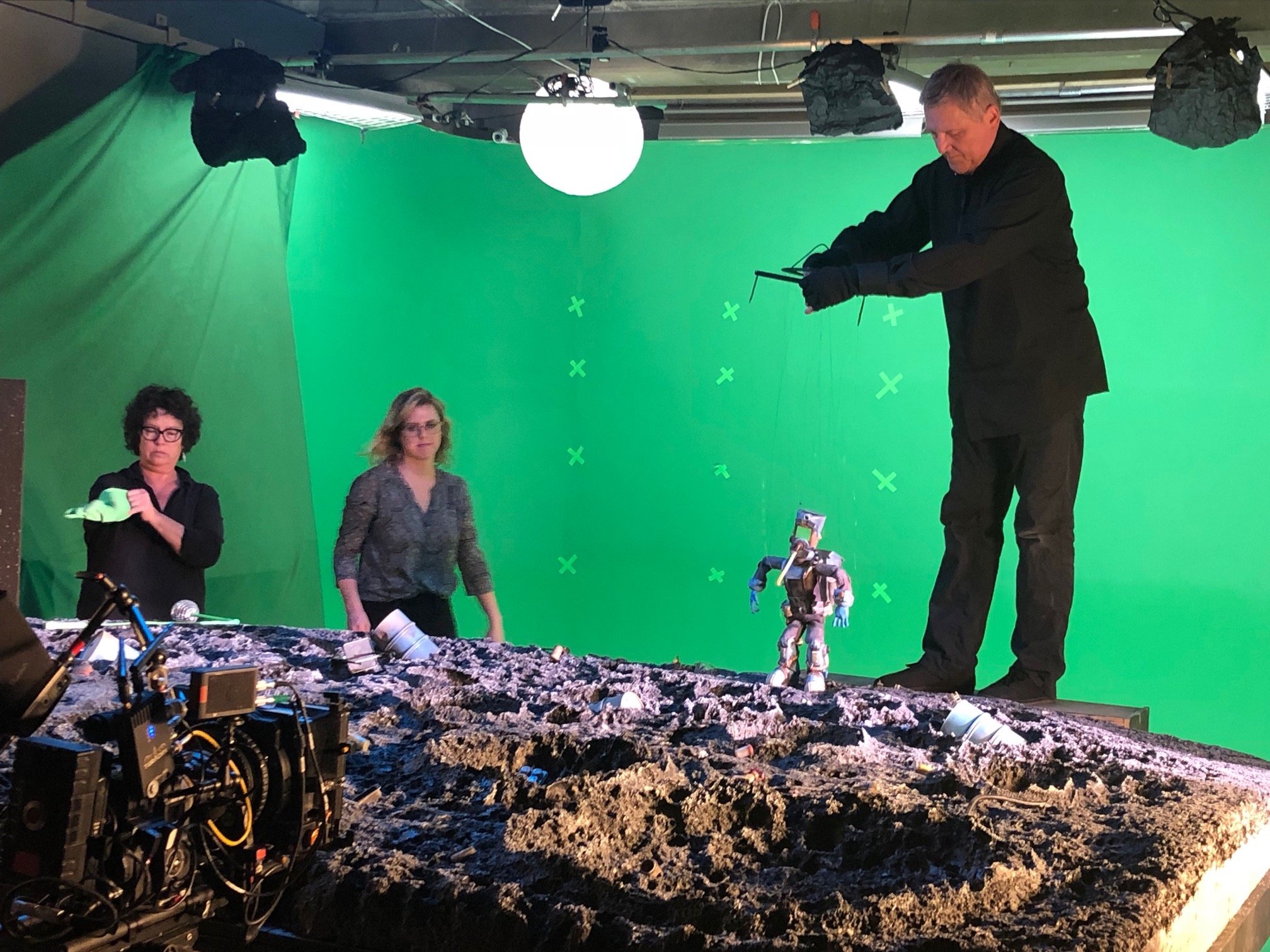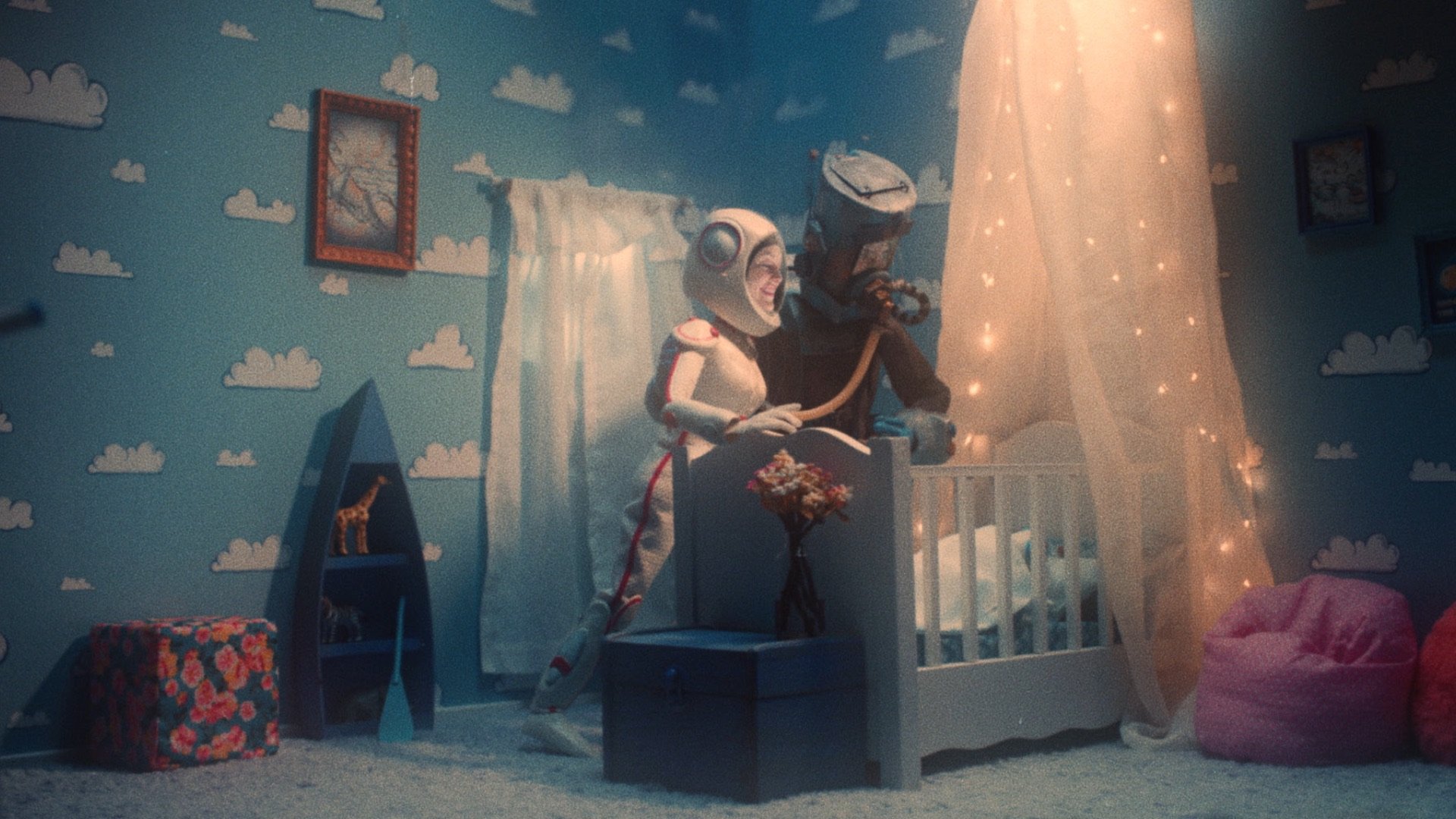
(Editor’s Note: In the feature below, Cosmic Fling producer Christian Hall provides a road map for how to maximize your post-production workflow.)
The process of post-production is the final gate between your footage and your audience. It’s an opportunity to refine, to create, or (as in our case) to build an entire world in outer space. In order to accomplish my short film, Cosmic Fling, organization and communication within our post-production workflow was key, especially as many of our post-production team worked remotely, providing its own set of challenges. Perhaps that’s where services like the ai automation tool come in to play.
Cosmic Fling follows Stan (Josh Fadem), a helpless romantic and intergalactic garbage man who lives alone on an asteroid until one day he spots Beatrice (Caitlin McGee), stranded on a comet hurtling by. Our story explores his conviction and aching desire to mend his loneliness. To provide a unique perspective on Stan and Beatrice’s plight, we decided to use marionettes in miniature environments. We shot against green screen backdrops, with green tape inside the visors of the puppet’s helmets with the idea of adding live-action performances in post-production.
Preventing post haste and waste
Planning for post began early as we discussed the requirements while reading the script. We asked as many questions as possible: What’s the simplest way to create a realistic starfield? Can we do it practically, instead of using computer-generated effects? How do we convincingly add human faces to the puppeted characters? How much can we rely on visual effects within our budget?
Decisions made before production begins have a major effect on what your post-production requirements are. For example, our fearless director Jonathan Langager, production designer Fon Davis (former Industrial Light & Magic model maker whose credits include the Star Wars prequels, Interstellar, The Nightmare Before Christmas) considered using a matte painting of distant stars and galaxies. Jonathan and I had worked with Fon previously, and we always loved the idea of practical solutions and in-camera effects, as in our previous film Penelope in the Treehouse for Disney Channel. Even using minimal microfilament strings—which reflect a lot of light—during a screen test, the decision was clear: Without a green screen, it’d be more of a burden to digitally enhance or remove strings. The downside of green screen, for many moviemakers, is the time and cost required to digitally build, light, and render an environment. But it also allows an enormous amount of creative flexibility, especially when it comes to highly stylized concepts. On Cosmic Fling, we had to consider the cost and time for string removal where strings would cross. Using green screen, a portion of the arduous string removal labor was minimized with compositing.
We knew from the get-go that VFX would play a significant part in production, which included set extensions, rotoscoping, compositing, and numerous plate shots and inserts to address. Our approach was to seek second opinions and quotes from multiple vendors through early conversations with VFX consultants and specialists. If the initial sticker price on VFX work is too high, it’s best to negotiate and explore alternative solutions to cut post-production costs. One strategy is to find artists and specialists whose skills are very specific. Working with your VFX supervisor, you can find ways to divide effects work based on the skills of artists. Turn-key VFX companies charge a lot more to do the same thing, especially if they rely on off-site contractors. It’s more work for you and your VFX supervisor, but the cost savings are considerable. Another strategy is to find ways to simplify the use of VFX assets in your sequences. If something can be done once and repeated in multiple shots, it saves time and money.

Task-trading post
Many VFX artists have preferences for what they enjoy working on. I found opportunities to present appealing tasks that fit those preferences while delegating other tasks to different artists. In turn, we were able to negotiate tasks that artists enjoyed while keeping costs under budget. Larger post-production vendors can outsource VFX work and don’t always guarantee quality, in- stead billing hourly or only allowing limited revisions. Have an open and honest dialogue with your VFX or post-production supervisor about your expectations and your budget.
Also read: Film Labor Laws: What Moviemakers Should Know
Understand that the choices you can make to achieve your vision in post-production will become severely limited once you’ve completed production. Once you’ve identified your needs, costs, and expectations before production, you’ll pave the way for a smooth post-production experience from the editing room to the mixing booth. It was the wisdom of our resident rock star and on-set VFX supervisor Tim Hendrix that guided us from production into post-production. He answered questions throughout the shoot, patiently listening as we wondered whether Stan’s helmet light should be on during certain shots or if our puppeteers should wear green suits in others. Tim understood which tasks would be easy in post-production and which wouldn’t. Joined by our primary VFX supervisor Ben Kadie, we developed a plan to address the impact of VFX on 100-plus shots in our film. Ben worked with us closely to break down the process into a manageable post-production workflow.
Tools of the trade
To assign shots and manage tasks, we used SHIFT, a post-production workflow collaboration and management tool, as well as other software. SHIFT allowed us to provide instant feedback and notes on shots in progress between our core team.
Our single source of truth was a VFX breakdown spreadsheet managed by Jonathan, Ben, and me. This breakdown thoroughly provided information for each shot with columns designated for various requirements such as wire removal, floating space debris, green screen removal, additional compositing, visor replacement with live action performances, and a priority status. This spreadsheet was used by all VFX artists on Ben’s team, allowing for everyone to work simultaneously and understand the various requirements for each shot.
When work was complete, we would receive notifications that a shot was uploaded and we would provide notes, sometimes revising shots and sequences four or five times. In order to keep the visual tone and style consistent with our effects crew, we shared visual references and held weekly conference calls to answer questions and walk through sequences in detail.
Working in glowing terms
One area I struggled with is how to accurately and effectively communicate what VFX solutions are required. Occasionally, this resulted in a conflict where an idea for the film was not properly transmitted to the VFX supervisor, and in turn, to the rest of the effects team. It’s crucial to ask for clarity and be as specific as possible with your vision, otherwise, the results may surprise you.
On Cosmic Fling, we had a specific idea for how we envisioned Beatrice’s comet. From our main character’s perspective, the moment the comet comes hurtling into view is one of the biggest and most hopeful of his life. Our goal was for the comet to have a distinct look, with a sparkle and shine, and we provided both practical and CG-oriented solutions to accomplish that vision.
Also read: Bong Joon-Ho’s Next Film After Parasite? Actually, There Are Two
Occasionally, when we used the descriptors “sparkle,” “shine,” or “glow,” what we envisioned would be at odds with the interpretation and technical implementation of our post team. We learned to prepare many specific descriptors and present visual references to talk through our vision. This preparation applies to practical FX on set, but it especially applies to VFX.
Your creative team often won’t have the ability to quickly realign when an artist is working. We could have an artist work extremely hard on a beautiful glow and sparkle on the comet, but if at the end of the week the deliverable doesn’t align with the creative vision, it results in lost work. Without a technical background, learning the tools and describing the types of textures, compositing techniques, rendering choices and software solutions is helpful practice for building the type of vocabulary to effectively communicate your vision. I’ve learned that the most effective way to achieve your desired result is to map out your technical strategy only when it remains consistent with the film’s vision.
Grow with the flow
Post-production is a process of creating a story from the footage you’ve shot. So, build a plan and plot out your post-production workflow early to help to keep your film under budget and on time. Communicate and articulate your expectations constantly. Once you’ve done that, you’ll begin to see how effective the process becomes, and how a positive working environment and your film’s success go hand in hand.

5 Keys to Post-Production Workflow
- Have an open and honest dialogue with your post supervisor about your expectations and your budget
- Understand that the choices you can make to achieve your vision in post will become severely limited once you’ve completed production
- Prepare many specific descriptors and present visual references to talk through your vision
- To keep your film’s visual tone and style consistent, hold weekly conference calls to answer questions from your crew and walk through sequences
- Map out your technical strategy only when it remains consistent with your vision for the film
Cosmic Fling recently played the Santa Barbara International Film Festival. Christian Hall made Cosmic Fling with the support of the inaugural SHIFT Creative Fund Filmmaking Grant.
